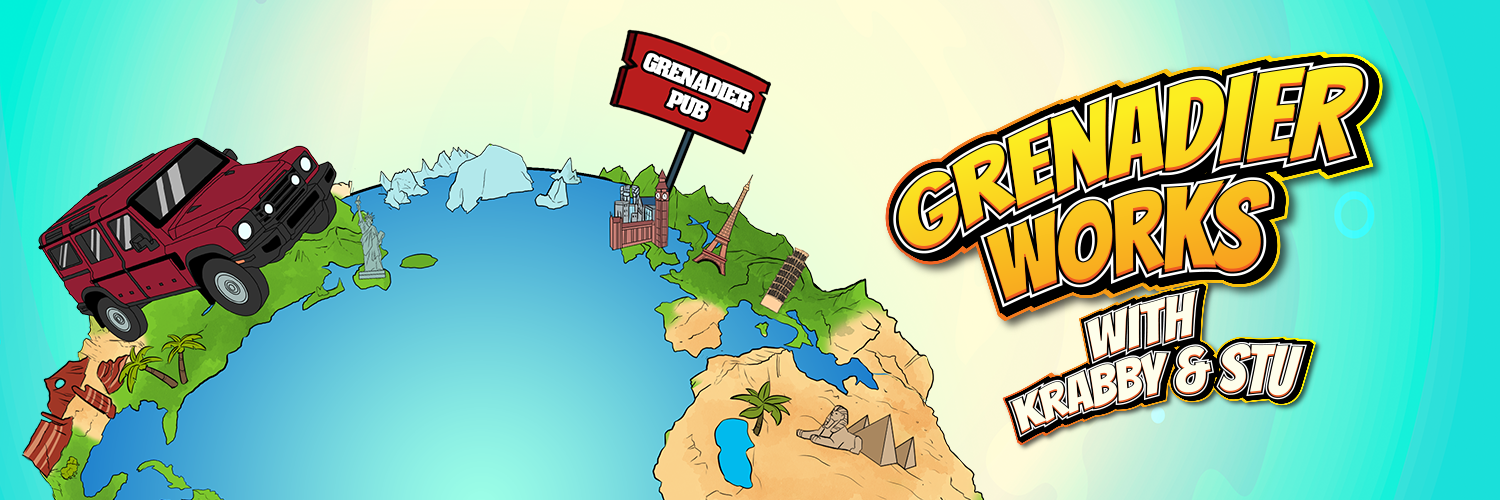Good point about the cost in markets outside the US. Yes I was referring to the Terraflex option for US owners. Replacing the shaft with a full OE assembly is not a modest cost in any market.Well actually it’s only a modest cost if using the Terraflex option and also that’s only in NA due shipping etc etc.
When you live in hard to reach places everything is expensive.
I’m regularly checking mine at only 25,000kms but with vin 193 lets say I’m not over optimistic
The Grenadier Forum
Register a free account today to become a member! Once signed in, you'll be able to contribute to the community by adding your own topics, posts, and connect with other members through your own private inbox! INEOS Agents, Dealers or Commercial vendors please use the contact us link at the bottom of the page.
You are using an out of date browser. It may not display this or other websites correctly.
You should upgrade or use an alternative browser.
You should upgrade or use an alternative browser.
Front Drive Shaft Repair Day
Well actually it’s only a modest cost if using the Terraflex option and also that’s only in NA due shipping etc etc.At this rate replacing the CV joint must be considered scheduled maintenance at 10K intervals. Check the boot regularly and if it fails replace it, but once you hit 10K failure is likely so just replace it proactively. At least it is a simple job that can be done without a big time commitment for modest cost.
When you live in hard to reach places everything is expensive.
I’m regularly checking mine at only 25,000kms but with vin 193 lets say I’m not over optimistic
My drive North of 1700 kms fully loaded will hopefully be “boot issue” free
Edit: sorry about double post, ran into “server error”
Given the Terraflex joint is less than $200 in the US I would rather replace it proactively than have it fail when deep in the back country. You could likely drive it out as the boot failure will at first just throw grease all over then start making noise, but better to avoid it happening at all while on a trip. The fix is super easy on the work bench. Less so while on my back in sand/dirt/rocks with a more limited selection of tools. Maybe for vehicles at OE suspension high the change interval could be extended to 15K miles/24K km. If you are lifted then the interval is 10K miles/16K km.Maybe that’s the case if you’ve had a suspension lift but not for stock vehicles.
Do we think IA is ever going to deal with the boot failing issues with some sort of design change even if it’s only limited to a change in boot style or material never mind all the contributing axle/drive shaft geometry complications? There is absolutely no way they are not aware these boots are failing and taking out the CVs as they get contaminated. They know this is happening in the field even on some stock ride height vehicles. Is there any hope if we keep our eyes peeled and peak under newer production models coming off the line going into next year we might see or notice a part number/component change? Wishful thinking I know.
The last feedback was that it's under review.Do we think IA is ever going to deal with the boot failing issues with some sort of design change even if it’s only limited to a change in boot style or material never mind all the contributing axle/drive shaft geometry complications? There is absolutely no way they are not aware these boots are failing and taking out the CVs as they get contaminated. They know this is happening in the field even on some stock ride height vehicles. Is there any hope if we keep our eyes peeled and peak under newer production models coming off the line going into next year we might see or notice a part number/component change? Wishful thinking I know.
Post in thread 'Front Driveshaft CV redesign' https://www.theineosforum.com/threads/front-driveshaft-cv-redesign.12419230/post-1333351461
An update is likely to happen eventually if for no reason other than IA wanting to stop the steady flow of warranty claims. The question is will the update be offered to existing owners and at what cost.Do we think IA is ever going to deal with the boot failing issues with some sort of design change even if it’s only limited to a change in boot style or material never mind all the contributing axle/drive shaft geometry complications? There is absolutely no way they are not aware these boots are failing and taking out the CVs as they get contaminated. They know this is happening in the field even on some stock ride height vehicles. Is there any hope if we keep our eyes peeled and peak under newer production models coming off the line going into next year we might see or notice a part number/component change? Wishful thinking I know.
I would assume they would want to stop information for potential customers instead of warranty repairs. I mean honestly if I knew this was an issue from stock and lifted and IA knowing there is a issue I might not have gotten one, but I'm also nutz and willing to roll dice. lolAn update is likely to happen eventually if for no reason other than IA wanting to stop the steady flow of warranty claims. The question is will the update be offered to existing owners and at what cost.
I regularly question my sanity for buying a Grenadier.I would assume they would want to stop information for potential customers instead of warranty repairs. I mean honestly if I knew this was an issue from stock and lifted and IA knowing there is a issue I might not have gotten one, but I'm also nutz and willing to roll dice. lol
An update is likely to happen eventually if for no reason other than IA wanting to stop the steady flow of warranty claims. The question is will the update be offered to existing owners and at what cost.
That would be my assumption and hope as well as you’d think they would want to stop failures and complaints impacting potential future sales. Hopefully buyers are doing do their own research and catching threads on this very forum.
However, I doubt we’ll see a recall and swap out of the front shafts on all Grenadiers produced thus far. It’s more likely going to be a case of stock versus modified, plus the mileage at point of failure, where we’ll each have to plead our individual cases based on what IA attributes the failure to. Lifted vehicles most likely all bets are off but stock vehicles may have some negotiating room.
It is for this reason that my Grenadier has no lift nor do I plan to install one. Given I am running 35" Mickey Thompson tires with zero rub not sure why lifting the rig would even be needed. But as I add weight via accessories and payload I will considering using the OE springs with a higher rate. Offering a range of spring rates is definitely something IA got right.That would be my assumption and hope as well as you’d think they would want to stop failures and complaints impacting potential future sales. Hopefully buyers are doing do their own research and catching threads on this very forum.
However, I doubt we’ll see a recall and swap out of the front shafts on all Grenadiers produced thus far. It’s more likely going to be a case of stock versus modified, plus the mileage at point of failure, where we’ll each have to plead our individual cases based on what IA attributes the failure to. Lifted vehicles most likely all bets are off but stock vehicles may have some negotiating room.
Yup, I’ve kept mine stock as well until this all plays out a bit more. Still don’t like the idea of a potential failure even in stock configuration but we are all in the same boat until IA figures it out.It is for this reason that my Grenadier has no lift nor do I plan to install one. Given I am running 35" Mickey Thompson tires with zero rub not sure why lifting the rig would even be needed. But as I add weight via accessories and payload I will considering using the OE springs with a higher rate. Offering a range of spring rates is definitely something IA got right.
I'm waiting to hear reports that even up sized tires are going to be grounds for warranty denial.It is for this reason that my Grenadier has no lift nor do I plan to install one. Given I am running 35" Mickey Thompson tires with zero rub not sure why lifting the rig would even be needed. But as I add weight via accessories and payload I will considering using the OE springs with a higher rate. Offering a range of spring rates is definitely something IA got right.
It is certainly a possibility, but talk about angering your customer base. It will be a full on mutiny.I'm waiting to hear reports that even up sized tires are going to be grounds for warranty denial.
Because it looks great and allows is lifted ones to clear the trails we ride better.It is for this reason that my Grenadier has no lift nor do I plan to install one. Given I am running 35" Mickey Thompson tires with zero rub not sure why lifting the rig would even be needed. But as I add weight via accessories and payload I will considering using the OE springs with a higher rate. Offering a range of spring rates is definitely something IA got right.
List of tools to keep on your truck to fix on the road:
Punch and hammer (in case the shaft is stuck and needs a push to separate from transfer case and front axle.
Hammer & Flat head (to bust off the back cap) to access C Clip.
Snap Ring Pliers - to remove C clip and install the new clip.
LOTS OF TOWELS OR RAGs - your hands will be full of grease reapplying the tube of grease to the joint.
Total time - 1.5-2.5 hrs depending if you have air tools or manual. I carry a power tank with an air wrench.
TeraFlex JL/JT Factory Replacement CV Joint Kit – High-Angle Rzeppa
T45 long Torx - to remove the OEM boltsPunch and hammer (in case the shaft is stuck and needs a push to separate from transfer case and front axle.
Hammer & Flat head (to bust off the back cap) to access C Clip.
Snap Ring Pliers - to remove C clip and install the new clip.
LOTS OF TOWELS OR RAGs - your hands will be full of grease reapplying the tube of grease to the joint.
Total time - 1.5-2.5 hrs depending if you have air tools or manual. I carry a power tank with an air wrench.
Last edited:
I will admit to being an outlier in that I prefer the looks of a low vehicle with limited gap to the fender, but I totally understand that many owners like the looks of a higher ride height. My personal philosophy is that you run the lowest height that allows for the desired tire size. On the Grenadier that means stock height for "skinny" 35 inch tires. And as I have said many times on this forum, lifting a solid axle rig with taller springs only does not increase tire clearance. You need to increase the bump stop height in junction with longer shocks that then maintain full suspension articulation. Otherwise all you are doing is moving the rig higher into its suspension travel which limits droop and has a negative impact on actual suspension performance. Yes you gain ground clearance but the vehicle becomes much more likely to lift tires in technical terrain and ride quality suffers. I am a long time participant in the Jeep world and no one lifts Jeeps with springs only. It is always springs, taller bump stops and longer shocks combined with other parts for taller lifts. It is curious that spring only lifts are the standard for Grenadiers which essentially have the same suspension setup as Wranglers.Because it looks great and allows is lifted ones to clear the trails we ride better.
Not to derail this thread about the front drive shaft. I'll take any further talk about suspension lifts to an appropriate thread.
It's not that simple. You are correct that if you compress both tires at the same time then you gain no clearance at all for tires. But........ that's not the whole story. By lifting you change in simplest terms the pivot or rotating axis of the axle. Meaning the tires can tuck inwards away from the fender flare better when lifted. And the increased height reduces the tendency to compress both tires fully to the stops. It's not ideal necessarily, but in practice it works for many.I will admit to being an outlier in that I prefer the looks of a low vehicle with limited gap to the fender, but I totally understand that many owners like the looks of a higher ride height. My personal philosophy is that you run the lowest height that allows for the desired tire size. On the Grenadier that means stock height for "skinny" 35 inch tires. And as I have said many times on this forum, lifting a solid axle rig with taller springs only does not increase tire clearance. You need to increase the bump stop height in junction with longer shocks that then maintain full suspension articulation. Otherwise all you are doing is moving the rig higher into its suspension travel which limits droop and has a negative impact on actual suspension performance. Yes you gain ground clearance but the vehicle becomes much more likely to lift tires in technical terrain and ride quality suffers. I am a long time participant in the Jeep world and no one lifts Jeeps with springs only. It is always springs, taller bump stops and longer shocks combined with other parts for taller lifts. It is curious that spring only lifts are the standard for Grenadiers which essentially have the same suspension setup as Wranglers.
Not to derail this thread about the front drive shaft. I'll take any further talk about suspension lifts to an appropriate thread.
But for me personally, I just needed the belly clearance. The Breakover is miserable on the Gren when in stock form. The tires I run fit perfectly fine at any height, but now my belly is a bit higher and I won't high center as easily. If I went taller to maybe a 37" tire I would be trimming fenders.
It is all about trade offs. I don't enjoy driving rocky terrain they way I once did so lower is better. For more technical terrain requiring ground clearance a higher lift makes sense. If I am to drive in the rocks give me a rig on 37s or 40s, then it can actually be fun.It's not that simple. You are correct that if you compress both tires at the same time then you gain no clearance at all for tires. But........ that's not the whole story. By lifting you change in simplest terms the pivot or rotating axis of the axle. Meaning the tires can tuck inwards away from the fender flare better when lifted. And the increased height reduces the tendency to compress both tires fully to the stops. It's not ideal necessarily, but in practice it works for many.
But for me personally, I just needed the belly clearance. The Breakover is miserable on the Gren when in stock form. The tires I run fit perfectly fine at any height, but now my belly is a bit higher and I won't high center as easily. If I went taller to maybe a 37" tire I would be trimming fenders.
Can't you pre grease and carry it in a ziplock bag like a wheel bearing?LOTS OF TOWELS OR RAGs - your hands will be full of grease reapplying the tube of grease to the joint.
Yes you can. I'd consider even vacuum bagging it.Can't you pre grease and carry it in a ziplock bag like a wheel bearing?
Similar threads
- Replies
- 847
- Views
- 47K
- Replies
- 65
- Views
- 4K
- Replies
- 0
- Views
- 449
- Replies
- 688
- Views
- 53K



